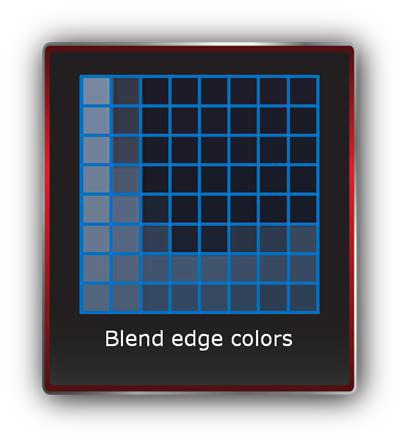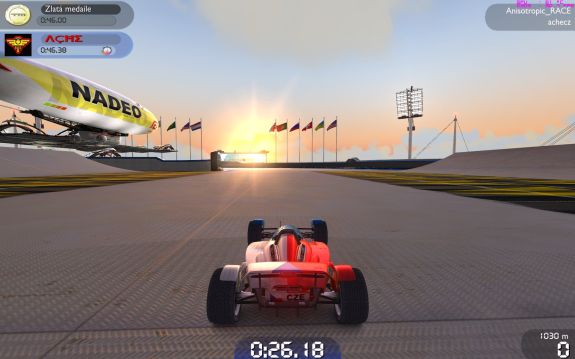AMD’s Radeon HD 6870 & 6850: Renewing Competition in the Mid-Range Market
by Ryan Smith on October 21, 2010 10:08 PM ESTHigh IQ: AMD Fixes Texture Filtering and Adds Morphological AA
“There’s nowhere left to go for quality beyond angle-independent filtering at the moment.”
With the launch of the 5800 series last year, I had high praise for AMD’s anisotropic filtering. AMD brought truly angle-independent filtering to gaming (and are still the only game in town), putting an end to angle-dependent deficiencies and especially AMD’s poor AF on the 4800 series. At both the 5800 series launch and the GTX 480 launch, I’ve said that I’ve been unable to find a meaningful difference or deficiency in AMD’s filtering quality, and NVIDIA was only deficienct by being not quite angle-independent. I have held – and continued to hold until last week – the opinion that there’s no practical difference between the two.
It turns out I was wrong. Whoops.
The same week as when I went down to Los Angeles for AMD’s 6800 series press event, a reader sent me a link to a couple of forum topics discussing AF quality. While I still think most of the differences are superficial, there was one shot comparing AMD and NVIDIA that caught my attention: Trackmania.
The shot clearly shows a transition between mipmaps on the road, something filtering is supposed to resolve. In this case it’s not a superficial difference; it’s very noticeable and very annoying.
AMD appears to agree with everyone else. As it turns out their texture mapping units on the 5000 series really do have an issue with texture filtering, specifically when it comes to “noisy” textures with complex regular patterns. AMD’s texture filtering algorithm was stumbling here and not properly blending the transitions between the mipmaps of these textures, resulting in the kind of visible transitions that we saw in the above Trackmania screenshot.

| Radeon HD 5870 | Radeon HD 6870 | GeForce GTX 480 |
So for the 6800 series, AMD has refined their texture filtering algorithm to better handle this case. Highly regular textures are now filtered properly so that there’s no longer a visible transition between them. As was the case when AMD added angle-independent filtering we can’t test the performance impact of this since we don’t have the ability to enable/disable this new filtering algorithm, but it should be free or close to it. In any case it doesn’t compromise AMD’s existing filtering features, and goes hand-in-hand with their existing angle-independent filtering.
At this point we’re still working on recreating the Trackmania scenario for a proper comparison (which we’ll add to this article when it’s done), but so far it looks good – we aren’t seeing the clear texture transitions that we do on the 5800 series. In an attempt to not make another foolish claim I’m not going to call it perfect, but from our testing we can’t find any clear game examples of where the 6870’s texture filtering is deficient compared to NVIDIA’s – they seem to be equals once again. And even the 5870 with its regular texture problem still does well in everything we’ve tested except Trackmania. As a result I don’t believe this change will be the deciding factor for most people besides the hardcore Trackmania players, but it’s always great to see progress on the texture filtering front.
Moving on from filtering, there’s the matter of anti-aliasing. AMD’s AA advantage from the launch of the 5800 series has evaporated over the last year with the introduction of the GeForce 400 series. With the GTX 480’s first major driver update we saw NVIDIA enable their transparency supersampling mode for DX10 games, on top of their existing ability to use CSAA coverage samples for Alpha To Coverage sampling. The result was that under DX10 NVIDIA has a clear advantage in heavily aliased games such as Crysis and Bad Company 2, where TrSS could smooth out many of the jaggies for a moderate but reasonable performance hit.
For the 6800 series AMD is once again working on their AA quality. While not necessarily a response to NVIDIA’s DX10/DX11 TrSS/SSAA abilities, AMD is introducing a new AA mode, Morphological Anti-Aliasing (MLAA), which should make them competitive with NVIDIA on DX10/DX11 games.
In a nutshell, MLAA is a post-process anti-aliasing filter. Traditional AA modes operate on an image before it’s done rendering and all of the rendering data is thrown away; MSAA for example works on polygon edges, and even TrSS needs to know where alpha covered textures are. MLAA on the other hand is applied to the final image after rendering, with no background knowledge of how it’s rendered. Specifically MLAA is looking for certain types of high-contrast boundaries, and when it finds them it treats them as if they were an aliasing artifact and blends the surrounding pixels to reduce the contrast and remove the aliasing.


MLAA is not a new AA method, but it is the first time we’re seeing it on a PC video card. It’s already in use on video game consoles, where it’s a cheap way to implement AA without requiring the kind of memory bandwidth MSAA requires. In fact it’s an all-around cheap way to perform AA, as it doesn’t require too much computational time either.
For the 6800 series, AMD is implementing MLAA as the ultimate solution to anti-aliasing. Because it’s a post-processing filter, it is API-agonistic, and will work with everything. Deferred rendering? Check. Alpha textures? Done. Screwball games like Bad Company 2 that alias everywhere? Can do! And it should be fast too; AMD says it’s no worse than tier Edge Detect AA mode.
So what’s the catch? The catch is that it’s a post-processing filter; it’s not genuine anti-aliasing as we know it because it’s not operating on the scene as its being rendered. Where traditional AA uses the rendering data to determine exactly what, where, and how to anti-alias things, MLAA is effectively a best-guess at anti-aliasing the final image. Based on what we’ve seen so far we expect that it’s going to try to anti-alias things from time to time that don’t need it, and that the resulting edges won’t be quite as well blended as with MSAA/SSAA. SSAA is still going to offer the best image quality (and this is something AMD has available under DX9), while MSAA + transparency/adaptive anti-aliasing will be the next best method.
Unfortunately AMD only delivered the drivers that enable MLAA yesterday, so we haven’t had a chance to go over the quality of MLAA in-depth. As it’s a post-processing filter we can actually see exactly how it affects images (AMD provides a handy tool to do this) so we’ll update this article shortly with our findings.
Finally, for those of you curious how this is being handled internally, this is actually being done by AMD’s drivers through a DirectCompute shader. Furthermore they’re taking heavy advantage of the Local Data Store of their SIMD design to keep adjacent pixels in memory to speed it up, with this being the biggest reason why it has such a low amount of overhead. Since it’s a Compute Shader, this also means that it should be capable of being back-ported to the 5000 series, although AMD has not committed to this yet. There doesn’t appear to be a technical reason why this isn’t possible, so ultimately it’s up to AMD and if they want to use it to drive 6800 series sales over 5000 series sales.











197 Comments
View All Comments
Ryan Smith - Friday, October 22, 2010 - link
In case it isn't obvious from the slipshod organization of the article, we didn't quite get it done on time. We had less than a week to put this article together when normally for an article of this size it takes 2 weeks. Check back in the morning, everything on Eyefinity, DP1.2, etc will be up by then.counter03 - Friday, October 22, 2010 - link
i am quite interested in that 'mst hub'.is there any available product now?well,i just find nothing with google.wolrah - Friday, October 22, 2010 - link
The card still has two TMDS clock generators. This means only two DVI/HDMI displays can be driven off the card at one time, no matter what connection. With that in mind, I wouldn't be surprised if the card doesn't even support passive adapters as there is literally no good reason to ever use them. You already have two native ports, so with a maximum of two DVI displays that's that.Regardless of if passive adapters are supported, you'll still need active adapters or native DisplayPort on your display to run three or four monitors off this card.
Supposedly it also supports DisplayPort daisy chaining, so possibly when monitors arrive that have an out port it may handle more than four displays, but again only a maximum of two can be DVI/HDMI without active adapters.
ninjaquick - Monday, October 25, 2010 - link
DP support shouldn't be a problem since I've seen quite a few monitors coming out with DP in and some with I/O.Abot13 - Saturday, October 23, 2010 - link
With the 6800 series the cards can support up to 6 monitors in Eyefinity. The DP ports can use a DP hub or the monitors can be chained with DP. Either way the max is 6 monitors per card.ol1bit - Thursday, October 21, 2010 - link
The naming stinks, but I can see how these cards will be a big Christmas season for AMD.So people that don't the new naming scheme will rush out an buy the bigger names. Smooth Marketing Move.
Well, if the 6900's launch next month, that will be fun to see.
Zokudu - Thursday, October 21, 2010 - link
You removed Left 4 Dead from your benchmarks. Does this mean you won't be replacing it with another Source game (ie L4D2 or maybe Portal 2 when that releases)?I know its not 100% perfect but 3 of the top 10 selling games on steam right now are run on the Source engine and the only other ones that share and engine are BF:BC2 and MoH both using Frostbite. I would think that having some form of a Source game in there would be a good idea considering the vast amount of popular games that run on it. I always used the L4D benchmark to compare performance for TF2 and CS:S. in the past.
Otherwise good review and I'm excited for the HD6900 launch next month.
Ryan Smith - Friday, October 22, 2010 - link
By the time Portal 2 comes out, it'll be about the time we refresh our suite anyhow. For the time being the existing Source games run on anything (even the GT 430 got L4D playable at 1680 with 4xAA) so it's not a useful benchmark, especially since there's no guarantee Portal will run that well.AmdInside - Thursday, October 21, 2010 - link
In the 3DTV Play article, you mentioned AMD's 6000 series would challenge NVIDIA in 3D with the 6000 series but I didn't read any info on it in this article. What gives?StevoLincolnite - Friday, October 22, 2010 - link
Also didn't see any mention of the improved crossfire performance either...